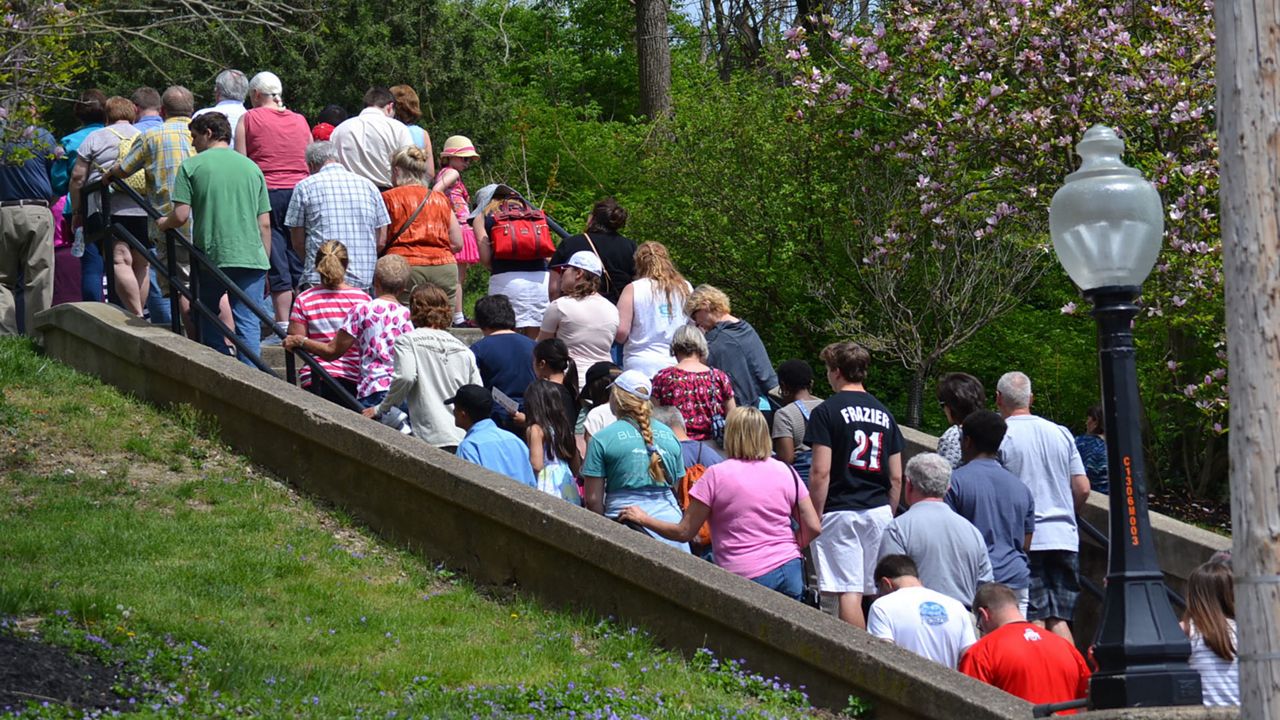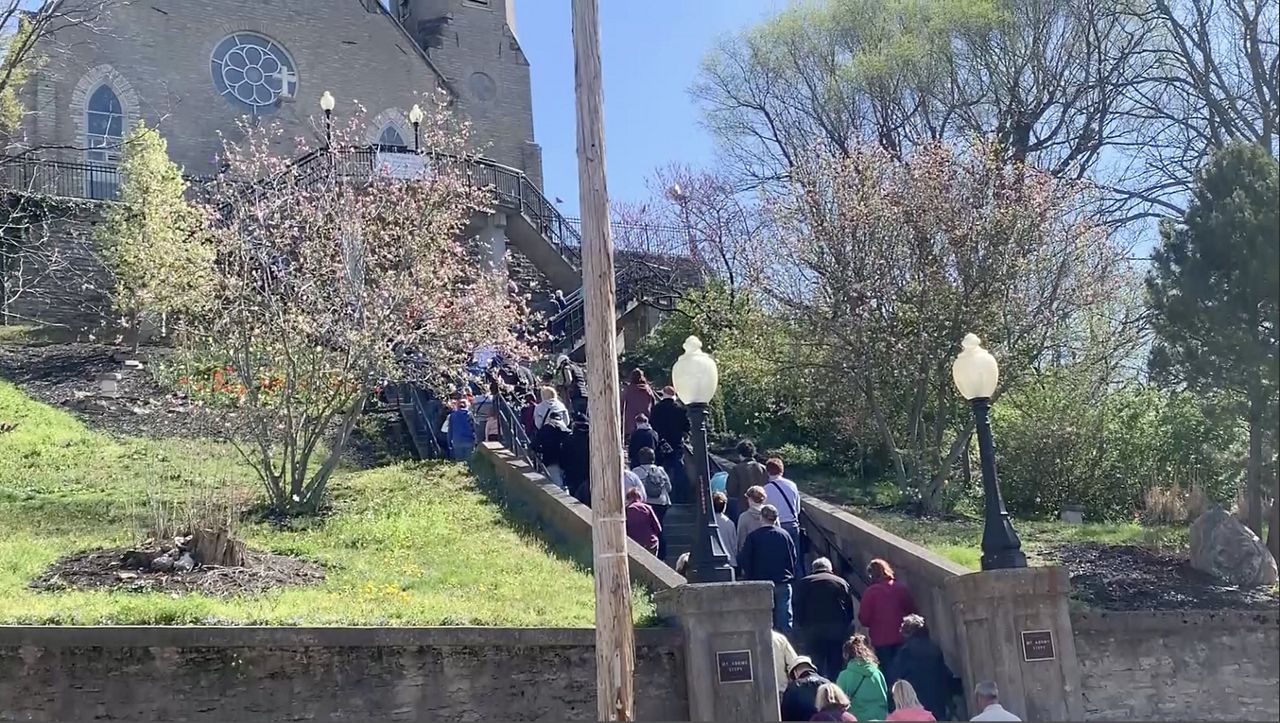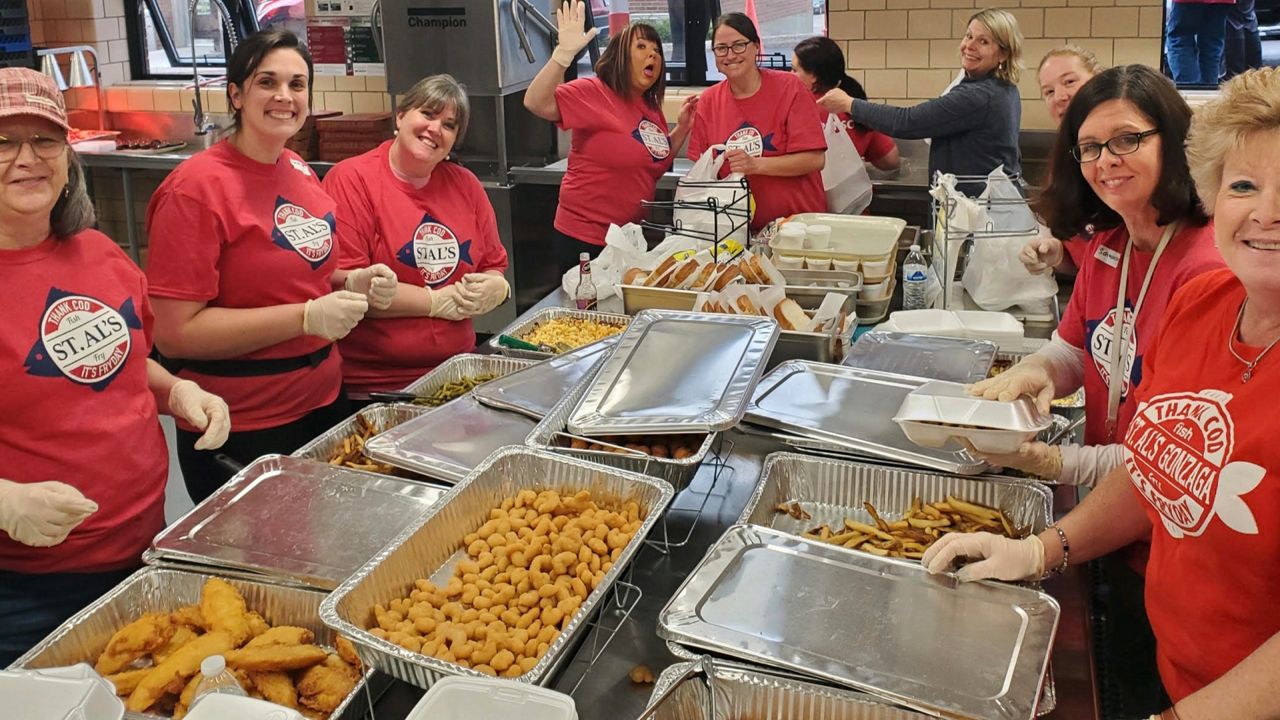CINCINNATI – Over the last 150 years, the stairs to Mount Adams have become an important component of Easter celebrations for thousands of Roman Catholics and other Christians in greater Cincinnati and beyond.
What You Need To Know
- Praying the steps to Holy Cross-Immaculata Parish has become an Easter tradition in Cincinnati
- Tens of thousands spend part of Good Friday climbing the 94 stairs to the church in Mount Adams
- For believers, Good Friday traditionally consists of fasting, penance and prayer.
- The tradition is more than 150 years old
Every year on Good Friday, 10,000 to 12,000 religious pilgrims converge on St. Gregory Street to pray the 94 steps leading to Holy Cross-Immaculata Parish. There are also two longer sets of stairs, but the shorter version is the most popular.
Good Friday is a holy day that falls on the Friday before Easter Sunday. On Good Friday, Christians around the world commemorate the doctrinal belief in the Crucifixion of Jesus Christ. The day traditionally consists of fasting, penance and prayer.

Unique to Cincinnati, the practice of climbing the steps developed in the mid-19th century around the time of the construction of the hilltop church.
“It’s really a beautiful event and very personal day for so many people,” said parish member Jim Steiner.
Steiner particiapted in the events in some manner for the past two decades. He’s there every year, helping organize the events taking place all day, as well as the night before, to get the church ready for the influx.
It’s not something he would have imagined when he moved to the neighborhood in 1999.
Although Roman Catholic, he previously considered himself a “C and E’er” or someone who only went to Mass on Christmas and Easter. But that changed when he moved to the area known as the “top of the hill.”
Living two blocks from the Church of the Immaculata, Steiner would see the church and its signature steeple and stained-glass rose-style window “every morning when I got up and every night when I went to bed.”
“I thought well, ‘I better go over and check it out’ and I walked in the place and immediately had this unexplained, unexplainable feeling,” he added. “It just felt good.”
Step climbers arrive as early as 11 or 11:30 p.m. on Holy Thursday, the night before Good Friday. At midnight, a priest will be the first to head up the steps, saying a prayer and blessing the staircase along the way.
Depending on the time of day, lines can get pretty long—“around the block, at least,” Steiner said. But neither the line, nor the wait, seem to discourage the devout.
The last time Steiner took part, he arrived “very, very early,” while it was still dark and bone-chilling cold. It was “spitting snow” for the entire hour-long process.
“I got onto the steps and it got very quiet, very calm and I just began to think about things that had happened in my life, things that have happened to me recently,” he said.
There were “no answers” received during his climb, Steiner added, but when he got to the top of the steps, something happened.
“I just felt cleansed and clearheaded,” he said. “I just felt good.”
Steiner doesn’t believe his experience was unique; he also doesn’t feel it was necessarily the norm, either.
“People have their own experiences, and that’s the point,” Steiner said. “It’s a very personal thing.”
Now 83, Steiner doesn’t climb the stairs as often as he once did. Beyond “just getting older,” Steiner had to sit on the sidelines the last two years because of COVID-19.
If he’s able to find free time later in the day, he will take part. His schedule is to work from about 4 a.m. to noon.
“I’d like to do the steps in the afternoon,” he said. “If my body lets me, I’ll do it.”
"Highest hill in the city"
To understand the event’s history, go back to 1848, when then-Bishop John Baptist Purcell purchased the land in Mount Adams that would eventually become the site of Immaculata Church.
Due partially to financial limitations, construction didn’t begin for several years.
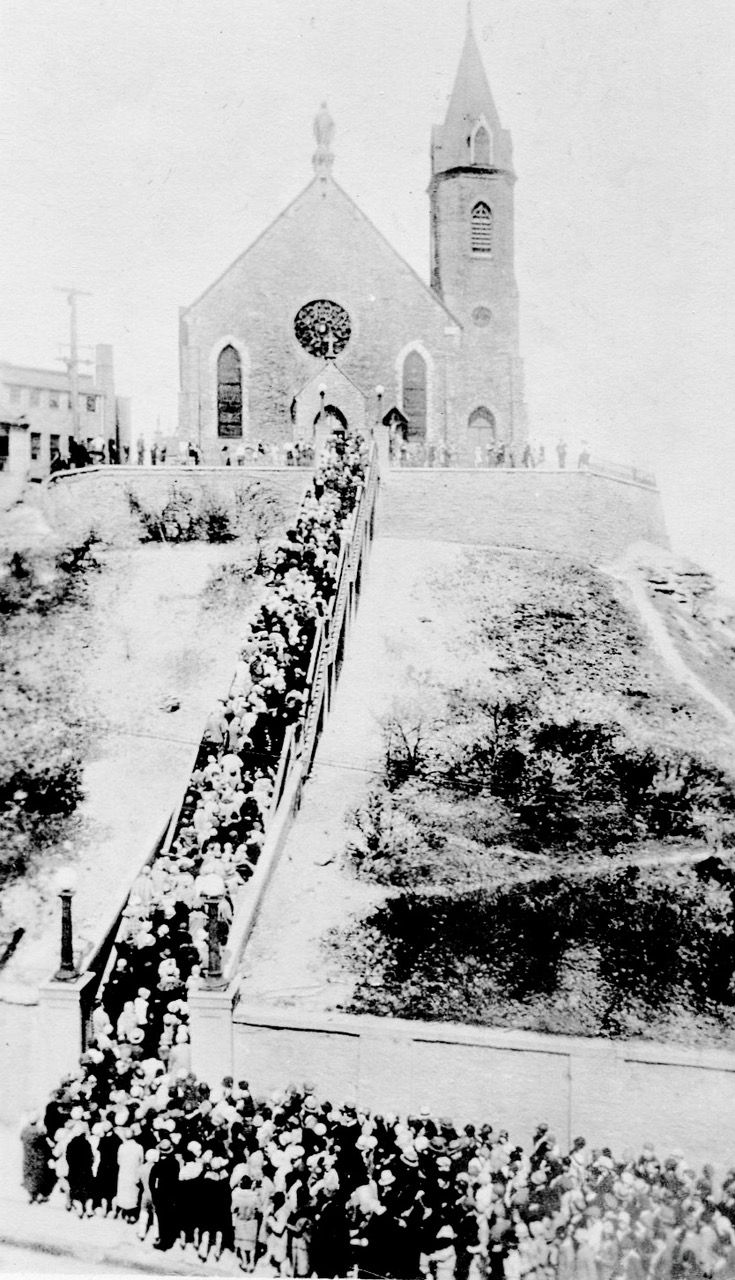
Legend has it that while returning from Rome in 1854, Purcell’s ship got caught in a violent storm. He reportedly prayed to Mary, Jesus’ mother, and promised to build a church on the “highest hill in the city if he survived the journey,” according to Rev. David Endres, a priest and church historian within the Archdiocese of Cincinnati.
In 1859, Purcell, now an archbishop, made good on his promise. On Aug. 21 of that year, Purcell laid the cornerstone of Immaculata Church, named for Mary as the Immaculate Conception.
“In terms of its spiritual development, the church started with what we might call a special prayer and ended in an answer to prayer,” Endres said.
The worksite became a popular meeting ground for Catholics and curious onlookers who wanted to watch the construction.
While the church was being built, they erected a large wooden cross on the grounds. The archbishop asked the city’s Catholics to pray for the success of the endeavor. Many prayed there, wearing a muddy path from the city’s urban center up the steep hill.
Partly because of safety concerns, the church built a set of wooden steps to help visitors get to the site. Concrete steps were first installed in 1911.
Soon the steps themselves became a means to devotion, offering the “invitation to pause and recite a 'Hail Mary' on each of the steps and an 'Our Father' on each landing,” according to Endres.
Through the prayers and tithing of the city’s Catholics, construction on the church finished in 1860, but the tradition of “praying the steps” continued.
No one seems to know for certain why it developed. But each year thousands of people from all 50 states, and even international visitors of all faiths, make a pilgrimage to Cincinnati to take part.
Praying step by step
In modern times, visitors at the steps can choose to begin from one of three locations: the upper steps, middle steps or lower steps.
Besides the St. Gregory Street steps just below the church entrance, there’s a middle set of steps, about 200 of them, that begin on Columbia Parkway.
The lower steps start on Riverside Drive, formerly Eastern Avenue, across from the Montgomery Inn Boathouse. The stairway got repaired in 2009 and now feature wider steps, pedestrian-scaled lighting and new landscaping and signage.
No set is more spiritual than another, Steiner said. Some may take a little longer to scale, though—upwards of two hours.
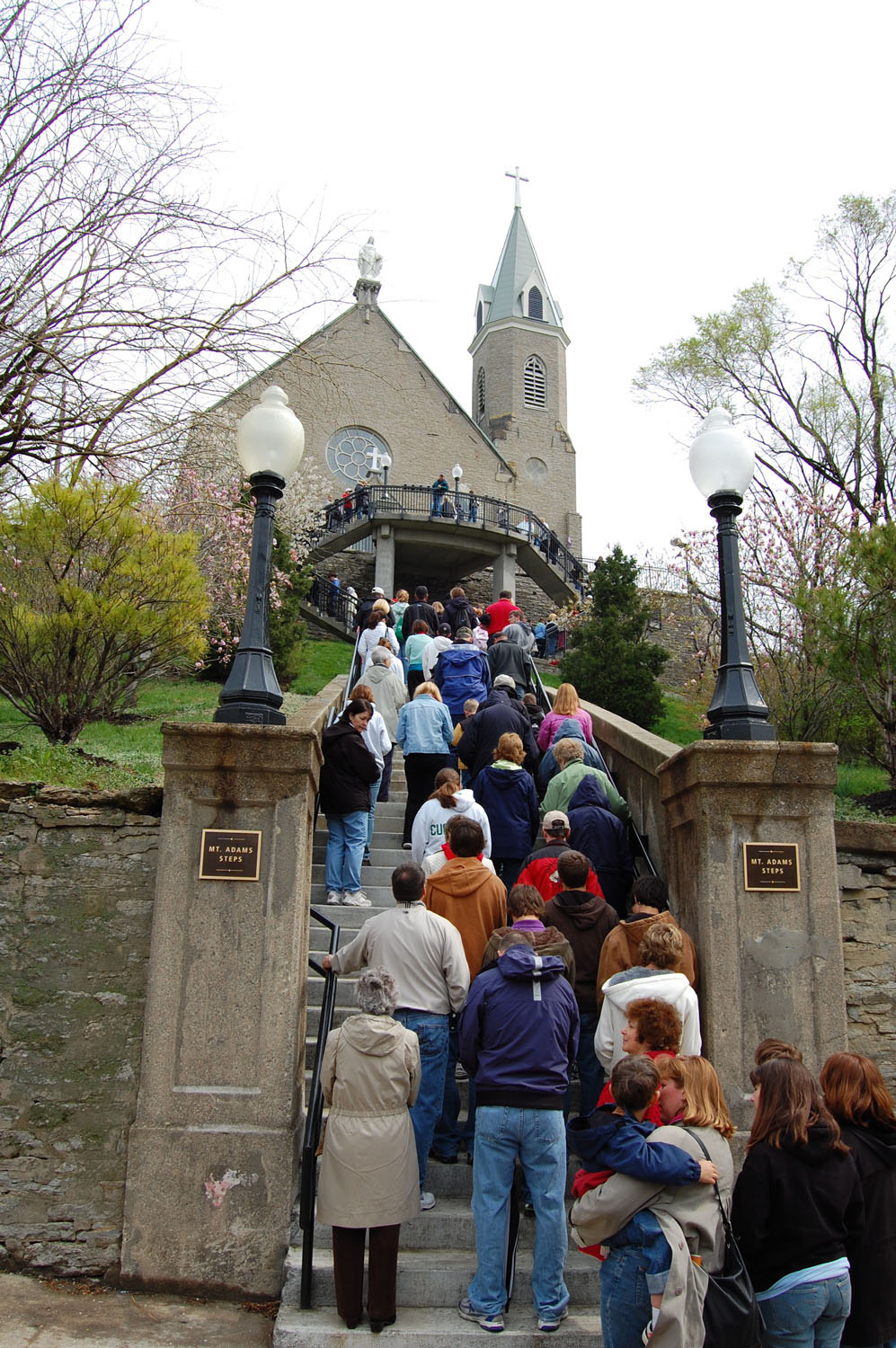
Tradition is an important part of being Catholic, Endres said. But many of those traditions have evolved based on people’s experiences, their personal needs and changes in society.
Praying the steps is a good example.
“Even though this is a devotion, which is literally more than 150 years old, it doesn’t always look the same over time,” Endres said. “Today, you see families, youth groups, even non-Catholics taking part, but they’re experiencing it based on their sense of spiritual needs, and spiritual identity.”
Still, there are some universal elements.
Endres mentioned the marking of Jesus’ death, something Christians revere everywhere. There are aspects of pilgrimage that are part of it—“the idea of taking a journey, moving into a separate space in order to gain some spiritual benefit.”
“There are certainly universal, transnational aspects of this, but then there’s also the very particular aspect of this being something that developed in Cincinnati,” he said. “Some families have passed down the tradition from generation to generation—and I expect it to continue for decades, maybe centuries, to come.”
Endres recalled corresponding with someone from Iowa who knew of Cincinnati in part because of this religious tradition.
“This has become something that a lot of people have recognized as unique to Cincinnati and as a mark of local interest,” he said.
Full day of worship and events
Although much of the focus falls on praying the steps, it’s just one part of a weekend full of religious events at the church.
“Each year, our parish looks forward to opening our doors to the thousands of pilgrims who visit,” said Amy Obermeyer, a representative of the parish. “Some people think we are a church that is only open on Good Friday. In fact, we are a vibrant parish, with over 250 Ohio and Kentucky families who are active in our many spiritual and social activities throughout the year.”
After the Mass of the Lord’s Supper on Holy Thursday at 7 p.m., Immaculata will remain open through the night and for the full 24 hours on Good Friday.
The blessing of the St. Gregory Street steps starts at midnight. Votive candles are available inside the church so those taking part can use them for prayer intentions. Visitors may also write a prayer request in the intention book.
For a portion of the day, priests will offer the Sacrament of Reconciliation inside the church, and outside the church when weather permits.
There are two Good Friday services scheduled, at 2 p.m. and 7 p.m. The services include the reading of the Passion Narrative, reception of Holy Communion and the Veneration of the Cross.
Holy Cross-Immaculata parishioners will serve donuts and coffee from 6 a.m. to 1 p.m., or until supplies run out. The parish’s traditional Good Friday fish fry won’t take place this year due to supply chain issues, the parish said.
The parish recommended those who want to picnic to consider purchasing lunch from a neighboring Mount Adams business.
For more information visit, www.hciparish.org.





